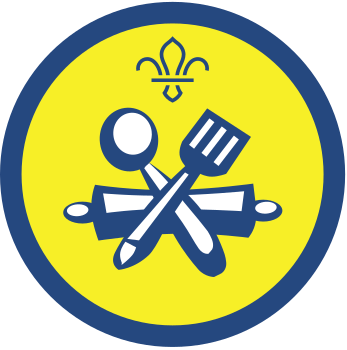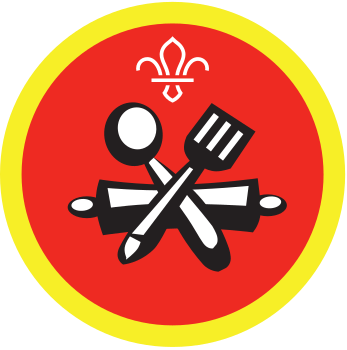
Bake Sugar Skull Biscuits
You’ll need
- Ingredients (see recipe)
- Access to an oven
- Skull shape biscuit cutter (can use skill silhouette printout and a knife as an alternative)
- Wooden spoons
- Knives
- Whisk
- Rolling pin
- Mixing bowls
- Baking trays
- Baking paper
- Weighing scale
- Teaspoons and tablespoons
- Heatproof oven gloves
- Tea towels
- Wire racks or a heatproof surface
- Timer
- Spatula or similar
- Plates
- Cleaning supplies such as anti-bacterial spray, washing up liquid, cloths
- Fire extinguisher or fire blanket
- First aid kit, including for burns
Before you begin
- Use the safety checklist to help you plan and risk assess your activity. Additional help to carry out your risk assessment, including examples can be found here. Don’t forget to make sure all young people and adults involved in the activity know how to take part safely.
- Make sure you’ll have enough adult helpers. You may need some parents and carers to help if you’re short on helpers.
Before you begin
- There’s lots of loud noises, sitting and different smells when eating, which may overwhelm some people. People may choose to wear ear defenders while eating, move around while eating or sit in a separate space to everyone and that’s OK.
- Be conscious about who may be fasting when providing snacks, eating and drinking – you may want to plan this activity for when everyone can get involved or leave out the eating and drinking part.
- Remember to have a hand washing station and take extra hygiene precautions when handling food. Take a look at our guidance on food preparation.
- You may want to run a fire safety talk or show people how to use the equipment safely, such as for cooking or chopping ingredients.
Planning this activity
- This activity does include talking about the death of family members or friends. Be especially sensitive if you know the topic of families is difficult for anyone. This activity gives everyone the chance to think about the helpful people in their lives, whoever they are.
- Be aware of your group’s needs and safeguarding requirements. Make sure you look out for these individuals and provide a safe and calm space for them to process their emotions. Always follow the Yellow Card.
- Make sure everyone knows they don’t have to share anything about themselves if they don’t want to. It’s important that everyone feels comfortable in this activity, as well as knowing how they can access support and who they can speak to in confidence. Always follow the Yellow Card.
- Check before and during the activity that everyone is comfortable, and make sure everyone knows that they can leave the activity at any point. It might be useful to agree a signal people can use, such as raising their hand, to stop take a break for the activity or if they need to speak to an adult.
- You could run our kitchen safety and hygiene activities, Kitchen risk bingo and Home kitchen hygiene prior to running this session.
Allergies and dietary requirements
- Remember to check for allergies, eating problems or dietary requirements and adjust the recipe as needed. Make sure you've checked everyone's dietary requirements and allergies then adapted the recipe as appropriate. This may include ensuring no cross-contamination during food preparation, too.
- Check if there are any items of food (or packaging) that people can’t touch or be near to or if there are items that people might not be comfortable using in the activity.
- Some people may not like certain food textures or tastes and that’s OK. Try to find an alternative for them. No-one has to use all the ingredients or be made to try foods if they’re not happy, comfortable or don’t want to.
Dia de los Muertos – or Day of the Dead – is a celebration that takes place most frequently in Mexico. It’s a time for families to honour their ancestors, meaning the people in their family who lived before them.
People believe spirits of loved ones who’ve died are allowed to return to Earth once a year, on this day. Day of the Dead is therefore seen as a family reunion, where family members that have died are honoured guests.
Day of the Dead is a joyful time that helps people remember their loved ones and celebrate their memory. Those who mark this day also believe that this celebration is an important step in helping support those who have died in their spiritual journey. There are then lots of food, crafts, singing, and parades for everyone to enjoy!
Everything about Day of the Dead is bright and colourful, especially the decorations. It’s a day about remembering and celebrating their lives and the impact they had upon the people they knew, as well as keeping in mind that just because they’re no longer with us doesn’t mean that they’re entirely gone, because we keep them alive in our hearts and memories.
Many people will make altars or “ofrendas” (offerings) in their homes to honour their loved ones who have died. Every ofrenda includes the four elements, which are water, wind, earth and fire. Water is left in a pitcher to allow spirits can quench their thirst. Earth is represented by food, especially bread. Fire is shown by candles, which are often left in the form of a cross, and are believed to help the spirits find their way. Papel picado, or traditional paper banners, represent the wind.
Ingredients
- 344g all-purpose flour
- 1 teaspoon baking soda
- 1/2 teaspoon baking powder
- 240g butter, softened
- 250g white sugar
- 1 egg
- 1 teaspoon vanilla extract
Icing
We suggest you use store bought icing, however, below is ingredients if making it from scratch is better for your group
- 300g confectioners’ sugar
- 2 large egg whites
- 1 to 2 teaspoons fresh lemon juice
- food colouring
- Sprinkles or other decorations
Get ready to bake
- Gather everyone together and explain that you’ll be making some biscuits in the shape of skulls, which is a common shape used in Day of the Dead celebrations. The skulls are used to mark loved ones we have lost and are colourfully decorated to celebrate their life.
- Everyone should wash their hands and get ready to cook. You might want to remind everyone about ways to keep safe in the kitchen you’re using and to regularly wash their hands, such as if they sneeze, touch their face or handle raw ingredients, such as egg.
Ready, steady, bake!
- Ask everyone to get into small groups and share out the ingredients and cooking equipment.
- An adult should preheat an oven to 190 degrees Celsius or 375 degrees Fahrenheit.
- In a small bowl, someone should add and stir together the flour, baking soda, and baking powder. Once finished, set this aside.
- In a large bowl, add the butter and the sugar, then use a whisk to mix these together until they’re smooth.
- Add eggs and vanilla essence to the butter and sugar and mix again.
- Gradually mix the dry ingredients (flour, baking soda and baking powder) into the larger bowl until they form a dough.
- On a clean surface, put down some flour and tip the dough from the larger bowl onto the floured surface.
- Slowly roll out the dough with rolling pin until it’s flat and even. It needs to be about 3-5mm thick, or about the thickness of a £1 coin.
- When ready, use a skull-shaped biscuit cutter to cut out some skull shaped biscuits. You may want to add flour to the biscuit cutter to make it easier. Once cut, place the shapes onto a baking tray.
- If you don’t have a skull shaped biscuit cutter, you could print out or draw a skull shape onto card, then place into onto the dough and cut around it. You may want to laminate it, so it can be wiped down, washed and cleaned.
- Keep cutting out the biscuit shapes until the dough is all gone.
Bake and cool
- When the biscuits are ready to go in the oven, an adult should place them in the pre-heated oven using heatproof gloves. While waiting, people could wash up the cooking equipment.
- They should bake until they're lightly browned. This should take around 8 to 10 minutes.
- When ready, an adult volunteer should wear heatproof gloves and carefully remove the biscuits from the oven
- Place the tray on a heatproof surface, away from young people.
- Give the biscuits time to cool down. Next, an adult should then use a spatula to carefully move the biscuits onto a wire rack or heatproof plate to finish cooling.
Icing and decorating!
Reminder – You can use store bought icing
- In the bowl of a standing mixer fitted with the paddle attachment, mix the confectioners’ sugar with the egg whites and 1 teaspoon lemon juice and beat on low to medium-low speed until the icing is completely smooth, which will take 3 to 5 minutes.
- When the paddle is lifted from the icing, a peak in the icing should be created. To reach the right consistency, add 1/2 teaspoon more egg whites and/or lemon juice at a time to thin the icing, or 1 teaspoon more confectioners’ sugar at a time to thicken the icing.
- Divide the icing into small bowls.
- You may want to add food colouring to create colourful icing. Remember to leave at least one bowl as white icing for the skulls. Divide the icing into bowls for the colours to be added to each one. Add more or less food colouring to the icing until you achieve the colours you want.
- Spread out any other decorations you might have, such as sprinkles or decoration icing pens, in bowls. Share the bowls of decorations between the groups.
- When they’re cool, share the biscuits out between everyone onto plates for people to decorate.
- Remind everyone that Day of the Dead is all about celebrating loved ones and lots of colour.
- Have fun decorating and eating your sugar skull cookies!
Reflection
People celebrate and honour their ancestors in different ways all around the world. This can be based on culture, religion or family tradition. What are some other ways people honour their ancestors? Some examples include funerals, holding events, making timelines, naming things after them or burials.
Have you ever heard of Day of the Dead before? Have you celebrated it? If you’re comfortable and happy to share, where and how did you celebrate?
Safety
All activities must be safely managed. You must complete a thorough risk assessment and take appropriate steps to reduce risk. Use the safety checklist to help you plan and risk assess your activity. Always get approval for the activity, and have suitable supervision and an InTouch process.
- Carbon Monoxide
Carbon monoxide (CO) is a serious risk, so make sure you cook or use appliances in a properly ventilated area. If you need a sheltered cooking area, consider an open sided gazebo, dining shelter or a marquee that has sufficient air circulation and ventilation. Take a look at our further guidance on carbon monoxide.
- Cooking
Teach young people how to use cooking equipment safely. Supervise them appropriately throughout. Make sure it’s safe to use and follow manufacturers’ guidelines for use.
- Food
Remember to check for allergies, eating problems, fasting or dietary requirements and adjust the recipe as needed. Make sure you’ve suitable areas for storing and preparing food and avoid cross contamination of different foods. Take a look at our guidance on food safety and hygiene.
- Hot items and hot water
Kettles, cookers and microwave ovens produce a lot of heat by the very nature of them. Caution is needed when in contact with items that have been heated and young people should use them under adult supervision. Use on a suitable surface, protecting it if necessary. Never leave hot items unattended and make sure there’s a nearby first aid kit, with items to treat burns/scalds.
Remember to check your ingredients against any allergy or dietary requirements to ensure everyone can enjoy the recipe. This may mean using alternative ingredients. To make vegan biscuits, you could use plant-based butter and replace the egg with 2 tablespoons of apple sauce.
There are lots of different jobs that need doing when planning, making and cooking on a kitchen. People can work in small groups or as a whole group, depending on what will work best for your group.
There’s a role for everyone, so encourage everyone to be involved in a way that works for them. Remind everyone it’s OK for people take different roles in this activity. Everyone should choose a task that suits them, with people helping with tasks that others may struggle more with. Some people may choose to read the weighing scale, lift and carry the ingredients or equipment, read the instructions, or stir, chop, or pour the mixture.
If anyone needs help or struggles with fine motor skills, give them the opportunity to work in pairs with another young person, with a young leader or an adult volunteer. They could use larger materials. You could swap out the items for something easier to handle.
Make sure the objects are placed in areas accessible for everyone in the group and all the materials are at a level that can be easily worked on by wheelchair users.
You could have print-outs of the recipe, including large print versions, to help everyone follow the instructions.
There are lots of loud noises and different smells in a kitchen or while cooking, which may overwhelm some people. People may choose to wear ear defenders while in the kitchen, take a break from the activity or prefer to stay a distance away from the activity and that’s OK. You could use fragrance free soap or washing up liquid or have items pre-chopped to reduce noise. You might also want to keep any blending, electric whisks or noisier equipment to being used in one room and shut the door, so people have an option to step out if it’s too loud.
Be conscious about who may be fasting when running this activity – you may want to plan it for when everyone can get involved.
Some people may not like certain food textures or tastes and that’s OK. Try to find an alternative for them. No-one should be made to try foods if they’re not happy, comfortable or don’t want to.
Remember, some baking and cooking activities can be done either sitting or standing – people can choose whichever way is best for them. People could work with a partner, with one taking on any standing tasks and the other doing tasks seated.
All Scout activities should be inclusive and accessible.
Add some other seasonal events to your programme thanks to our occasions and events calendar.




